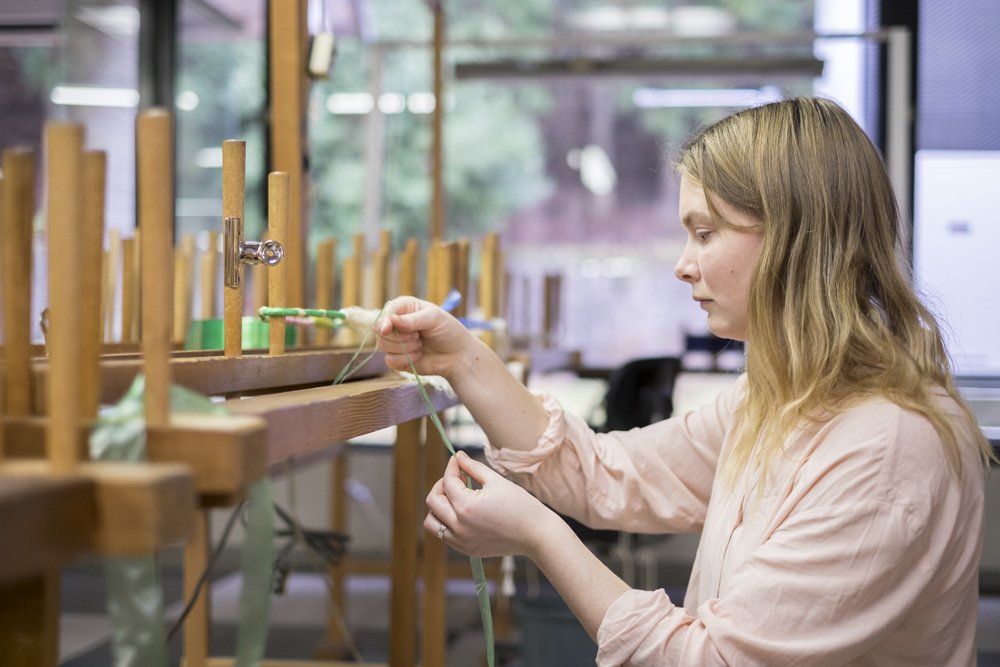Studying in Japan
I arrived at the Kawashima Textile School -KTS- on Saturday morning. Quiet all around, the peace of the weekend in a Kyoto suburban neighborhood surrounded by green mountains. The quiet continued until Monday morning, ending with a buzz of activity, the rhythm of shuttles and beaters in the spacious workshops.
I met my teacher, Ms. Kozue Yamamoto (called “Yamamoto Sensei” in Japanese, meaning “Teacher Ms. Yamamoto”),and thus began five weeks of study of the traditional Japanese weaving technique, Kasuri. The technique involves tie-dying of the undressed warp or weft, to create patterns and images. KTS is a school of textile design attached to the textile company “Kawashima Selkon Textiles Co., Ltd”. The school offers a variety ofprograms, including Advanced Courses (one year to three years), Technical Study Courses (short-term and six-month), and workshops ranging from a day to a week or more in weaving and dying.
The company is a story in itself. Working side by side are some of the world’s leading textile designers creating designs for manufacture, and hand craftsmen working in traditional techniques to weave obis (the broad kimono belt) in superfine silk threads. These hand weavers sometimes weave only three centimeters in a day.
Adjacent to the company is a museum, with a collection of breathtaking antique cloths between the 5th century and the 18th century, and designs and samples woven in the company over the past 140 years. Those antique cloths were the foundation of the Kawashima’s design sources, and the products woven basing onthese samples decorated the halls of the Imperial palace and the homes of the aristocracy.The museum and the school are an expression of Kawashima’s commitment to the weaving history of Japan, past present and future.
I found KTS by an internet search. I was looking for a place to study traditional Japanese techniques. When I arrived I knew almost nothing about the place, but I quickly found myself at home in this “Disneyland” for lovers of fiber.
Yamamoto Sensei showed herself from the start to be a very professional teacher. Only later, when we had learned to communicate in fractured Japanese, English, Hebrew, hand signs and drawings, did I discover her sense of humor and enthusiasm.
Ms. Suzumi Noda, the director of the school, is a Japanese fiber artist and textile designer of renown. She appeared daily at the school in clothes of her own unfettered imagination: jeans with red Lego bricks sewn in, pink hats and bracelets of colored pig suede.
Ms. Kimiko Kawamata was my translator and chaperone. One of the only people on campus who spoke passable English, she helped me whenever I needed, translating teacher’s instructions and helping me find my way around Kyoto’s beautiful sites.
I quickly became immersed in work. I learned to tie-dye warp and weft. I spent hours trying to create the traditional Japanese designs of crescent moons and birds. The technique involves wrapping groups of warp or weft threads with a dye-repellent plastic thread, then dying the whole skein. Then, when weaving, the undyed patches must line up exactly to create the design. I worked from early morning until workshop closing at nine or ten at night, alongside other students weaving kimonos from superfine threads, spinning and dying.
A week after I arrived, I joined the class for a tour of Hiroyuki Shindo, a fiber artist whom I had longed to meet. Hiroyuki Shindo lives in a remote village, two hours from Kyoto. He told us that he says a prayer to the god of indigo before he dips his threads in the dye-pot in his workshop.
Another field trip was to the “Gallery Gallery”, a textile gallery in the heart of Kyoto. There we saw an exhibit of damask weaving by a Japanese fiber artist who uses a weft of polished stainless steel rods to create designs of pattern and reflection.
During my free weekends, I wandered about the galleries of Kyoto, where I saw examples of Japan’s textile tradition – an art anchored in the past but with sites to renewal and the future.
After five weeks of work at KTS, I began to understand the concept of “the art of Zen” in the fibers – the art of deep concentration and attention to every single thread, dedication to work and the sense that the fibers of the warp and weft are an extension of myself. I learned the passion of the thread and the fabric.
Ziva Epstein Moshav Magshimim, Israel
June 3, 2008
Subscribe to:
Posts (Atom)


